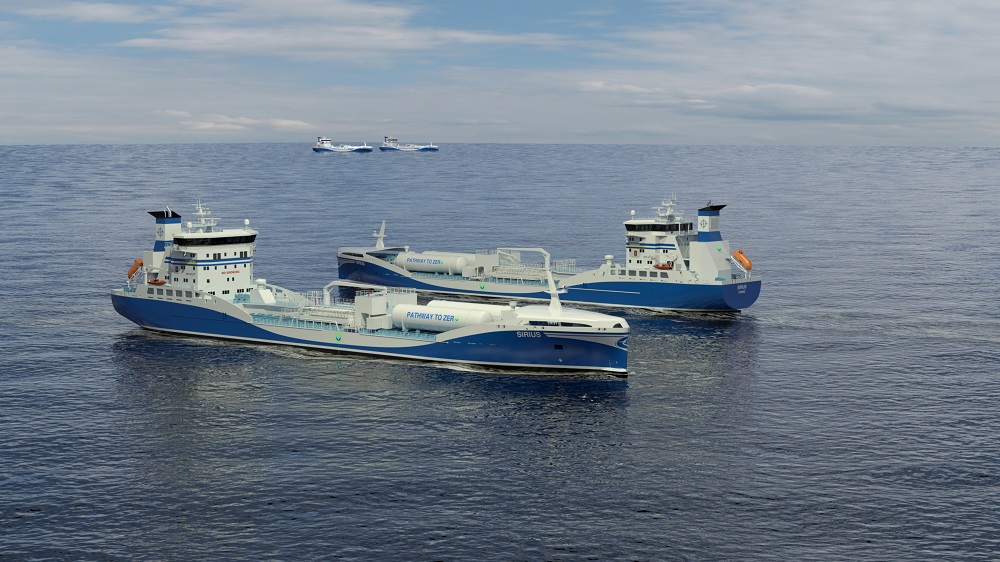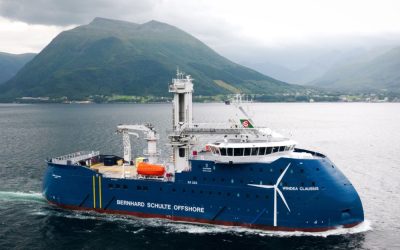Kongsberg Maritime to provide design, engineering and equipment on two methanol-ready chemical tankers for Swedish shipping firm
In 2010, Sirius Shipping’s chemical tanker Olympus became the first in the world to reduce its NOx emissions by 90% through retrofitting. Today, the vessel sails with pioneering equipment that controls emissions on all engines and saves fuel by recycling exhaust heat.
The Olympus is an indicator of Sirius’s long-term efforts to achieve greener shipping, with the Swedish tanker operator noting that an awareness of threats to the global environment like acid rain, eutrophication and climate change forms a natural part of its daily operations in Northern Europe. “We transport oil and chemicals in a sensitive environment. Our vision is for our ships to emit no harmful substances at all,” says managing director Jonas Backman.
As part of this vision, Sirius is developing a portfolio of newbuilds that is says will be among the market leaders in its segments and recently awarded Kongsberg Maritime a contract to provide the design, engineering and equipment for two cutting-edge MGO/biofuel and methanol-ready chemical tankers.
“The partnership with Kongsberg started several years ago when we were working closely to find the best future vessels for our customers,” says Backman. “They listen to our requirements and goals for low-emission vessels and at the same time make a workplace for our crew to feel safe and at home. This has resulted in a contract for the two newbuildings, with the ambition for many more. With these vessels we are well on our ‘Pathway to ZERO’.”
An evolution in tanker design
The new vessels will be highly advanced, low-emission 15,000dwt tankers with a range of Kongsberg Maritime equipment that can operate on battery-powered hybrid propulsion. Options for two further vessels are included. For Kongsberg Maritime, the collaboration with Sirius builds on a current nine-ship programme with fellow Swedish owner Terntank, with a similar design and equipment package.
Per Egil Vedlog, chief designer, Kongsberg Maritime Ship Design Solutions, tells TNA: “We are embracing the fuel transition and a big desire to adopt sustainable technologies. Our new chemical tanker design has now received combined orders for 11 ships, and these really are the next generation of cargo ship, with a combination of energy saving technologies.”
Vedlog continues: “The first nine ships, ordered in three batches by Terntank, are based on our super-efficient hull form, and feature progressive steps to improve efficiency through the use of methanol fuel, batteries, onshore power and even wind-assisted propulsion on the final three. These will be highly efficient ships and will have an Energy Efficiency Design Index above 40% below the 2025 Phase 3 requirements.
“This series continues with Sirius’s order for two more vessel of a very similar design, without suction sails.”
All 11 vessels will be built by China Merchants Jinling Shipyard. The first ship for Sirius will be delivered in July 2026.
Kongsberg Maritime’s contract with Sirius is valued at around NOK100 million (approximately €8.3 million). As part of the contract the company will also supply steering gear, Promas with flap rudder and CPP, tunnel thruster with Mcon thruster control system, K-Chief integrated automation systems including Vessel Insight, AutoChief propulsion control system and deck machinery. This is in addition to design and engineering services.
The company’s NVC 614 CT design, part of what has been dubbed the Evolution 15K series, features a hull form of Ice Class 1A, with a wave-piercing bow and distinct styling of the forecastle deck and forward and aft signal masts to match the design of rest of the Sirius fleet. “Our patented wave-piercing bow shape helps the vessel cut through waves, reducing slamming and fuel consumption,” explains Vedlog. “It is well suited to cargo and passenger operations and in rough weather can help the vessel maintain speeds by cutting through waves, rather than riding over them.
“The hull is Ice Class 1A efficiency, and there is a more streamlined design for the whale deck, to suit the styling of the Sirius fleet. In addition to significantly less resistance in rough sea conditions, reduced acceleration gives less sloshing in cargo tanks and better comfort.”
Vedlog adds that the cargo operation working area is under shelter by an enclosed deck trunk for safe operation in harsh winter conditions. All main cargo equipment is arranged in the deck trunk for easy and safe maintenance and operation. The cargo system features 14 epoxy coated cargo tanks and 14 submerged electric or hydraulic operated cargo pumps. Cargo capacity is approximately 16,780m3.
Main propulsion and manoeuvring for the 147.9m vessel are provided by Kongsberg Maritime’s Promas propulsion system. “With over 400 references across a range of ship types, Promas combines rudder and controllable pitch propeller into one propulsion system which optimises the hydrodynamic properties of the ship and delivers increased efficiency and thrust while using less energy. It has proved a popular solution with a fuel saving of around 6%,” notes Vedlog
He adds: “Compared to conventional propellers, the rudder forces with Promas are also much higher, meaning drag is reduced and this improves slow speed and harbour manoeuvring. The rudder will also have a flap to increase manoeuvring performance in narrow harbours.”
Transformative collaborations
Vedlog concludes that Kongsberg Maritime is delighted to be working with Sirius and China Merchants Jinling Shipyard on the project. It is a feeling echoed by both the Chinese yard, which has gained valuable experience in constructing chemical tankers for European owners, and Sirius.
According to a China Merchants Jinling Shipyard spokesperson: “Since the yard signed the first 15,000ton LNG dual-fuel chemical tanker contract with Kongsberg Maritime’s design team in 2014, we have opened the door to the chemical tanker market in Northern Europe with cutting-edge energy-saving and low-carbon designs such as dual-fuel propulsion, in-line shaft generator and DC-link.
“This was already an advanced design over eight years ago, it was a challenge for China Merchants Jinling Shipyard and Kongsberg Maritime, but we succeeded with our joint efforts. We hope to continue to work with Kongsberg Maritime in the future to design and build future ships that are more popular with the market and shipowners.”
Sirius MD Backman observes: “With Evolution 15K we’re taking another step forward – for our customers, colleagues and the environment. Our new tanker has been designed to provide the highest levels of sustainability, efficiency and safety as well as excellent working conditions.”




